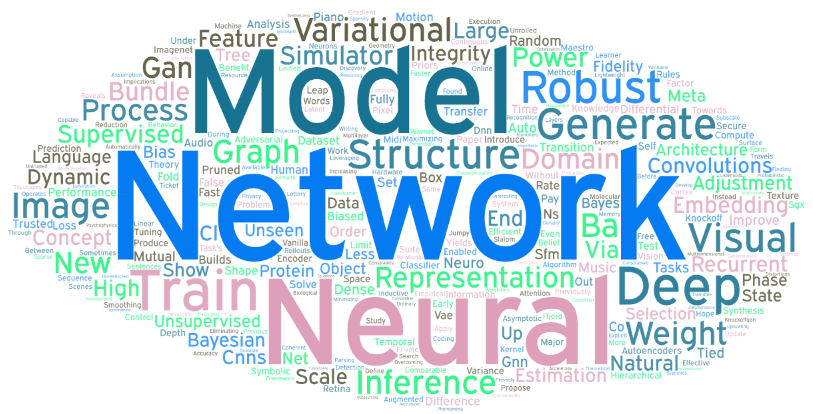【ICLR2019】Oral 论文汇总
ICLR2019 Oral 口头报告系列文章汇总
|
BA-Net: Dense Bundle Adjustment Networks
Keywords: Structure-from-Motion, Bundle Adjustment, Dense Depth Estimation TL;DR: This paper introduces a network architecture to solve the structure-from-motion (SfM) problem via feature bundle adjustment (BA) |
|
Deterministic Variational Inference for Robust Bayesian Neural Networks
Keywords: Bayesian neural network, variational inference, variational bayes, variance reduction, empirical bayes TL;DR: A method for eliminating gradient variance and automatically tuning priors for effective training of bayesian neural networks |
|
Ordered Neurons: Integrating Tree Structures into Recurrent Neural Networks
Keywords: Deep Learning, Natural Language Processing, Recurrent Neural Networks, Language Modeling TL;DR: We introduce a new inductive bias that integrates tree structures in recurrent neural networks. |
|
Large Scale GAN Training for High Fidelity Natural Image Synthesis
Keywords: GANs, Generative Models, Large Scale Training, Deep Learning TL;DR: GANs benefit from scaling up. |
|
Learning deep representations by mutual information estimation and maximization
Keywords: representation learning, unsupervised learning, deep learning TL;DR: We learn deep representation by maximizing mutual information, leveraging structure in the objective, and are able to compute with fully supervised classifiers with comparable architectures |
|
KnockoffGAN: Generating Knockoffs for Feature Selection using Generative Adversarial Networks
Keywords: Knockoff model, Feature selection, False discovery rate control, Generative Adversarial networks |
|
Learning Protein Structure with a Differentiable Simulator
Keywords: generative models, simulators, molecular modeling, proteins, structured prediction TL;DR: We use an unrolled simulator as an end-to-end differentiable model of protein structure and show it can (sometimes) hierarchically generalize to unseen fold topologies. |
|
ImageNet-trained CNNs are biased towards texture; increasing shape bias improves accuracy and robustness
Keywords: deep learning, psychophysics, representation learning, object recognition, robustness, neural networks, data augmentation TL;DR: ImageNet-trained CNNs are biased towards object texture (instead of shape like humans). Overcoming this major difference between human and machine vision yields improved detection performance and previously unseen robustness to image distortions. |
|
Smoothing the Geometry of Probabilistic Box Embeddings
Keywords: embeddings, order embeddings, knowledge graph embedding, relational learning TL;DR: Improve hierarchical embedding models using kernel smoothing |
|
On Random Deep Weight-Tied Autoencoders: Exact Asymptotic Analysis, Phase Transitions, and Implications to Training
Keywords: Random Deep Autoencoders, Exact Asymptotic Analysis, Phase Transitions TL;DR: We study the behavior of weight-tied multilayer vanilla autoencoders under the assumption of random weights. Via an exact characterization in the limit of large dimensions, our analysis reveals interesting phase transition phenomena. |
|
Meta-Learning Update Rules for Unsupervised Representation Learning
Keywords: Meta-learning, unsupervised learning, representation learning TL;DR: We learn an unsupervised learning algorithm that produces useful representations from a set of supervised tasks. At test-time, we apply this algorithm to new tasks without any supervision and show performance comparable to a VAE. |
|
Transferring Knowledge across Learning Processes
Keywords: meta-learning, transfer learning TL;DR: We propose Leap, a framework that transfers knowledge across learning processes by minimizing the expected distance the training process travels on a task's loss surface. |
|
GENERATING HIGH FIDELITY IMAGES WITH SUBSCALE PIXEL NETWORKS AND MULTIDIMENSIONAL UPSCALING TL;DR: We show that autoregressive models can generate high fidelity images. |
|
Temporal Difference Variational Auto-Encoder
Keywords: generative models, variational auto-encoders, state space models, temporal difference learning TL;DR: Generative model of temporal data, that builds online belief state, operates in latent space, does jumpy predictions and rollouts of states. |
|
A Unified Theory of Early Visual Representations from Retina to Cortex through Anatomically Constrained Deep CNNs
Keywords: visual system, convolutional neural networks, efficient coding, retina TL;DR: We reproduced neural representations found in biological visual systems by simulating their neural resource constraints in a deep convolutional model. |
|
Pay Less Attention with Lightweight and Dynamic Convolutions
Keywords: Deep learning, sequence to sequence learning, convolutional neural networks, generative models TL;DR: Dynamic lightweight convolutions are competitive to self-attention on language tasks. |
|
Enabling Factorized Piano Music Modeling and Generation with the MAESTRO Dataset
Keywords: music, piano transcription, transformer, wavnet, audio synthesis, dataset, midi TL;DR: We train a suite of models capable of transcribing, composing, and synthesizing audio waveforms with coherent musical structure, enabled by the new MAESTRO dataset. |
|
Learning to Remember More with Less Memorization
Keywords: memory-augmented neural networks, writing optimization |
|
Learning Robust Representations by Projecting Superficial Statistics Out
Keywords: domain generalization, robustness TL;DR: Building on previous work on domain generalization, we hope to produce a classifier that will generalize to previously unseen domains, even when domain identifiers are not available during training. |
|
Slalom: Fast, Verifiable and Private Execution of Neural Networks in Trusted Hardware
Keywords: Trusted hardware, integrity, privacy, secure inference, SGX TL;DR: We accelerate secure DNN inference in trusted execution environments (by a factor 4x-20x) by selectively outsourcing the computation of linear layers to a faster yet untrusted co-processor. |
|
The Neuro-Symbolic Concept Learner: Interpreting Scenes, Words, and Sentences From Natural Supervision
Keywords: Neuro-Symbolic Representations, Concept Learning, Visual Reasoning TL;DR: We propose the Neuro-Symbolic Concept Learner (NS-CL), a model that learns visual concepts, words, and semantic parsing of sentences without explicit supervision on any of them. |
|
The Lottery Ticket Hypothesis: Finding Sparse, Trainable Neural Networks
Keywords: Neural networks, sparsity, pruning, compression, performance, architecture search TL;DR: Feedforward neural networks that can have weights pruned after training could have had the same weights pruned before training |
|
FFJORD: Free-Form Continuous Dynamics for Scalable Reversible Generative Models
Keywords: generative models, density estimation, approximate inference, ordinary differential equations TL;DR: We use continuous time dynamics to define a generative model with exact likelihoods and efficient sampling that is parameterized by unrestricted neural networks. |
|
How Powerful are Graph Neural Networks?
Keywords: graph neural networks, theory, deep learning, representational power, graph isomorphism, deep multisets TL;DR: We develop theoretical foundations for the expressive power of GNNs and design a provably most powerful GNN. |






